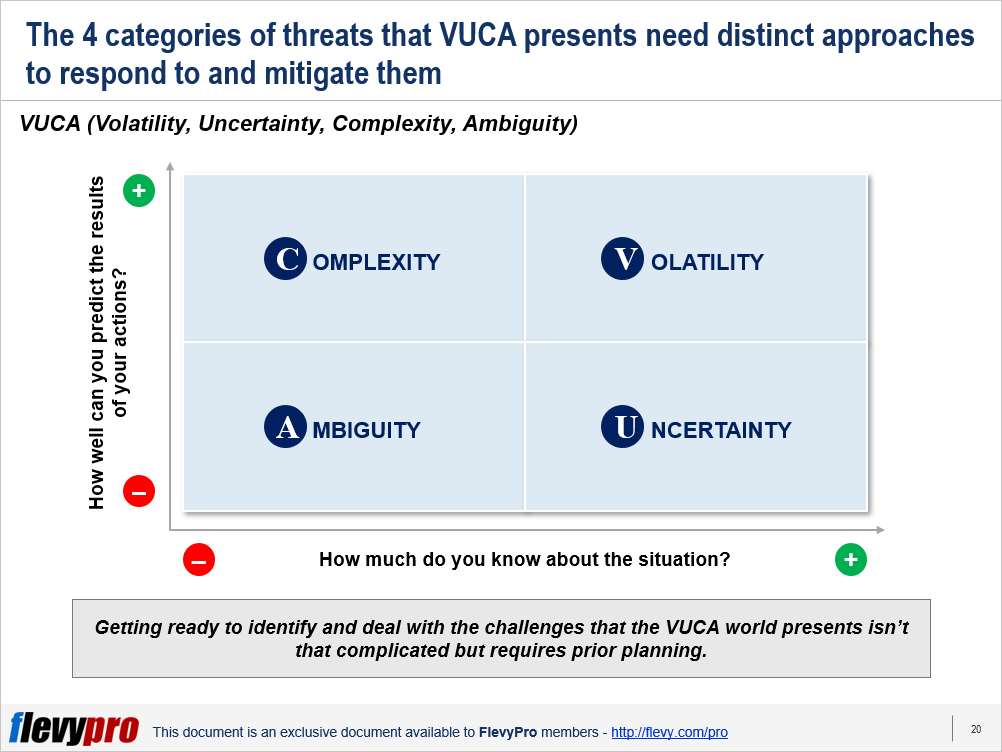VUCA relates to threats that people and enterprises often encounter. The acronym reflects the constant, dramatically-transforming, and unpredictable world. The concept originated in 1987, based on the theories of Warren Bennis and Burt Nanus. The term was first used by U.S. Army War College to describe the volatile, uncertain, complex, and ambiguous general conditions globally.
The acronym found traction after 2002, when it was considered an emerging idea to be discussed among the strategic leadership. The term VUCA stands for:
- Volatility
- Uncertainty
- Complexity
- Ambiguity
The 4 VUCA challenges reflect the unpredictable forces of change that affect organizations, necessitating new skills, approaches, and behaviors to mitigate them. The 4 elements of VUCA relate to how people view the situations where they make decisions, formulate plans, respond to challenges, cultivate change, and solve issues.
VUCA is a practical code for anticipation, understanding, preparedness, and intervention in the wake of uncertainty and confusion. One of the biggest challenges of managing in a VUCA world involves team members who resist change. Simply training the leaders on key capabilities isn’t adequate to avoid failures resulting due to not handling the VUCA issues properly. What differentiates sound Leadership from mediocre management is the leaders’ ability to ascertain key elements that prevent them from adopting resilience and flexibility.
In this age of disruption, Volatility, Uncertainty, Complexity, and Ambiguity are widespread. These elements will be more prevalent across industries and enterprises in future, and if not managed properly can sap an organization’s and its employees’ strengths.
Let’s discuss these VUCA elements individually.
Volatility
The Volatility element of VUCA talks about the distinct situational categorization of people due to their specific traits or their reactions in particular situations. People react differently in specific settings due to social cues. Volatility describes the influence of situations on stereotypes and social categorization, which is the reason why people perceive others differently.
Two factors connect people to their social identities: Normative fit and Comparative Fit. Normative fit is the degree that a person relates to the stereotypes and norms that others associate with their specific identity. For example, a Hispanic woman cleaning a house does not get gender stereotypes from others in this situation, but when she eats an enchilada ethnic stereotypes emerge and the gender is forgotten. Comparative fit relates to specific traits of a person that are prominent in certain states compared to others, which are obvious as others around a person do not have those traits. For example, a woman in a room full of men stands out, whereas all the men are grouped together.
Uncertainty
The Uncertainty element of VUCA pertains to the unpredictability of information in events, which often occurs in the intention to indicate correlation between events. Uncertainty is often counteracted by using social categorization (stereotypes), as people tend to engage in social categorization when there isn’t much data about an event.
For instance, when there isn’t enough information to clearly appreciate someone's gender—as in case of an author’s name when discussing written information—majority of people presume the author is a male. Social categorization also occurs in case of a race, when people stereotype a certain race to a particular trait. For example, basketball players are most of the time assumed as black people while golfers are expected to be white.
Complexity
The Complexity element of VUCA relates to the inter-relatedness of several factors in a system. Complexities due to interactions and dependencies within groups and categories bring unexpected results even in a controlled environment. There are certain identities in individuals that are more dominant than others. Other people distinguish these identities, make their assumptions about them, and create stereotypes. However, complexity in a person’s personality makes it difficult to socially categorize that individual accurately.
Different categories trigger in the mind of the observer, creating positive and negative perception. It is that positive perception that the observer is more open-minded despite stereotypes and think past the target’s dominant social trait. Complexities in social identities cause some identities to lessen the noticeability of other identities, making the targets unnoticeable and overlooked.
Interested in learning more about the elements of a VUCA environment, its mitigation, and Robert Johansen’s leadership framework “VUCA Counterweight” or “VUCA PRIME?” You can download an editable PowerPoint on VUCA (Volatility, Uncertainty, Complexity, and Ambiguity) here on the Flevy documents marketplace.
Are you a Management Consultant?
You can download this and hundreds of other consulting frameworks and consulting training guides from the FlevyPro library.

Comments